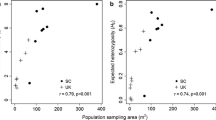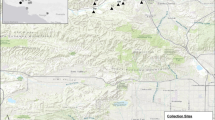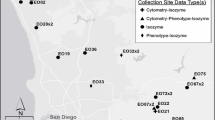Abstract
The purpose of his research was to describethe organization of genetic variation in thefederally endangered plant taxon Eriogonumovalifolium var. vineum using allozymes. Such information can help prioritize sites andmanagement choices for capturing andmaintaining genetic variation and can reducethe number of populations necessary to committo conservation, thus reducing costs andconflicts with competing land uses. Information on genetic diversity patterns alsoprovides insight into evolutionary anddemographic history of a taxon which canprovide means to assess future risk of erosionof diversity. Similar to other Eriogonumovalifolium varieties, E. ovalifoliumvar. vineum is diverse atboth the taxon (proportion of polymorphic loci[P] = 0.55 and alleles per locus [A] =5.45 [SD = 2.5]) and population (P = 0.56 [SD =0.11] and A = 2.68 [SD = 0.35]) levels. Gene diversity (H e) withinpopulations averaged 0.19 (SD = 0.03). Wefound some evidence for limited clonalreproduction within populations. Populationswere moderately differentiated from one another(ΘS = 0.14) and showed moderatedeviations from Hardy-Weinberg equilibriumwithin populations (f = 0.14 and F =0.19). Mean Nei's genetic distance (D)among all pairs of populations was 0.02. Populations with high levels of multiplemeasures of genetic diversity, high levels ofdifferentiation, and low levels of apparentinbreeding are suggested as conservationpriorities.
Similar content being viewed by others
References
Allphin L, Windham MD, Harper KT (1998) Genetic diversity and gene flow in the endangered dwarf bear poppy, Arctomecon humilis (Papaveraceae). Amer. J. Bot., 85, 1251-1261.
Archibald JK, Wolf PG, Tepedino VJ, Bair J (2001) Genetic relationships and population structure of the endangered steamboat buckwheat Eriogonum ovalifolium var. williamsiae. Amer. J. Bot., 88, 608-615.
Bataillon TM, David JL, Schoen DJ (1996) Neutral genetic markers and conservation genetics: Simulated germplasm collection. Genetics, 144, 409-417.
Brown AHD (1989) Genetic characterization of plant mating systems. In: Plant Population Genetics, Breeding, and Genetic Resources (eds. Brown AHD, Clegg MT, Kahler AL, Weir BS), pp. 145-162. Sinauer, Sunderland, Massachusetts, USA.
Butcher PA, Moran GF, Perkins HD (1998) RFLP diversity in nuclear genome of Acacia mangium. Heredity, 81, 205-213.
Calzia JP (1993) Mineral Resource Assessment of the San Bernardino National Forest, California; Executive Summary and a Nontechnical Summary for Land and Resource Managers. United States Geological Survey. Open File Report 93-0552. 11 pp.
Ceska JF, Affolter JM, Hamrick JC (1997) Developing a sampling strategy for Baptisia arachnifera based on allozyme diversity. Conserv. Biol., 11, 1133-1139.
Cheliak WM, Pitel JA (1984) Electrophoretic identification of clones in trembling aspen. Can. J. For. Res., 13, 740-743.
Cruzan MB (1998) Genetic markers in plant evolutionary ecology. Ecology, 79, 400-412.
Cruzan MB (2001) Population size and fragmentation thresholds for the maintenance of genetic diversity in the herbaceous endemic Scutellaria montana (Lamiaceae). Evolution, 55, 1569-1580.
Eguiarte LE, Perez-Nasser N, Pinero D (1991) Genetic structure, outcrossing rate and heterosis in Astrocaryum mexicanum (tropical palm): Implications for evolution and conservation. Heredity, 69, 217-228.
Ellstrand NC (1992) Gene flow among seed plant populations. New Forests, 6, 241-256.
Ellstrand NC, Elam DR (1993) Population genetic consequences of small population size: Implications for plant conservation. Ann. Rev. Ecol. Syst., 24, 217-242.
Ellstrand NC, Roose ML (1987) Patterns of genotypic diversity in clonal plant species. Amer. J. Bot., 74, 123-131.
Environmental Systems Research Institute (1996) ArcView 3.2. Environmental Systems Research Institute. Redlands, CA, USA.
Fenster C, Ritland K (1992) Chloroplast DNA and isozyme diversty in two Mimulus species (Scrophulariaceae) with contrasting mating systems. Amer. J. Bot., 79, 1440-1447.
Frankel OH, Soulé ME (1981) Conservation and Evolution. Cambridge University Press, Cambridge, England.
Gaines MS, Diffendorfer JE, Tamarin RH, Whittam TS (1997) The effects of habitat fragmentation on the genetic structure of small mammal populations. J. Hered., 88, 294-304.
Godt MJW, Johnson BR, Hamrick JL (1996) Genetic diversity and population size in four rare southern Appalachian plant species. Conserv. Biol., 10, 796-805.
Gonella MP, Neel M (1995) Characterization of rare plant habitat for restoration in the San Bernardino National Forest. In: Proceedings: Wildland Shrub and Arid Land Restoration Symposium (eds. Roundy BA, McArther ED, Haley JS, Mann DK), pp. 81-93. General Technical Report INT-GTR-315. USDA Forest Service, Intermountain Research Station, Ogden, Utah.
Hamrick JL, Godt MJW(1989) Allozyme diversity in plant species. In: Plant Population Genetics; Breeding and Genetic Resources (eds. Brown AHD, Clegg MT, Kahler AL, Weir BS), pp. 43-63. Sinauer, Sunderland, Massachusetts, USA.
Hartl DL, Clark AG (1997) Principles of Population Genetics, 3rd edn. Sinauer Associates, Sunderland, Massachusetts, USA.
Heywood JS (1980) Genetic Correlates of Edaphic Differentiation and Endemism in Gaillardia. Ph.D. dissertation, University of Texas, Austin, Texas, USA.
Hickman J (1993) The Jepson Manual. University of California, Berkeley, California, USA.
Holsinger KE, Gottlieb LD (1991) Conservation of rare and endangered plants: Principles and prospects. In: Genetics and Conservation of Rare Plants (eds. Falk DA, Holsinger KE), pp. 149-170. Oxford University Press, New York, New York, USA.
Holtsford TP, Ellstrand NC (1989) Variation in outcrossing rate and population genetic structure of Clarkia tembloriensis (Onagraceae). Theor. Appl. Gen., 78, 480-488.
Holtsford TP, Ellstrand NC (1990) Inbreeding effects in Clarkia tembloriensis (Onagraceae) populations with different natural outcrossing rates. Evolution, 44, 2031-2046.
Huenneke LF (1991) Ecological implications of genetic variation in plant populations. In: Genetics and Conservation of Rare Plants (eds. Falk DA, Holsinger KE), pp. 31-44. Oxford University Press, New York, New York, USA.
Husband BC, Schemske DW (1996) Evolution of the magnitude and timing of inbreeding depression in plants. Evolution, 50, 54-70.
Latta RG, Mitton JB (1997) A comparison of population differentiation across four classes of gene markers in limber pine (Pinus flexilis James). Genetics, 146, 1153-1163.
Lewis PO, Zaykin D (2001) Genetic Data Analysis: Computer Program for the Analysis of Allelic Data. Version 1.0 (d16c). Available from http://alleyn.eeb.uconn.edu/gda/.
Linhart YB, Grant MC (1996) Evolutionary significance of local genetic differentiation in plants. Ann. Rev. Ecol. Syst., 27, 237-277.
Loveless MD, Hamrick JL (1989) Ecological determinants of genetic structure in plant populations. Ann. Rev. Ecol. Syst., 15, 65-95.
Lynch M (1996) A quantitative-genetic perspective on conservation issues. In: Conservation Genetics: Case Histories from Nature (eds. Avise JC, Hamrick JL), pp. 471-482. Chapman and Hall, New York, New York, USA.
McCauley DE (1997) The relative contributions of seed and pollen movement to the local genetic structure of Silene alba. J. Hered., 88, 257-263.
McCune B, Mefford MJ (1999) PC-ORD. Multivariate Analysis of Ecological Data. Version 4.0. MJM Software Design, Gleneden Beach, Oregon. USA.
McKay, JK, Latta RG (2002) Adaptive population divergence: markers QTL and traits. Trends Ecol. Evol., 17, 285-291.
Milligan BG, Leebens-Mack J, Strand AE (1994) Conservation genetics: Beyond the maintenance of marker diversity. Mol. Ecol., 3, 423-435.
Mitton JB, Linhart YB, Sturgeon KB, Hamrick JL (1979) Allozyme polymorphisms detected in mature needle tissue of ponderosa pine. The Journal of Heredity, 70, 86-89.
Mitton JB, Grant MC, Yoshino AM (1998) Variation in allozymes and stomatal size in pinyon (Pinus edulis, Pinaceae), associated with soil moisture. Amer. J. Bot., 85, 1262-1265.
Montalvo AM, Conard SG, Conkle MT, Hodgskiss PD (1997) Population structure, genetic diversity, and clone formation in Querus chrysolepis (Fagaceae). Amer. J. Bot., 84, 1553-1564.
Murawski DA, Nimal Gunatilleke I, Bawa KS (1994) The effects of selective logging on inbreeding in Shorea megistophylla (Dipterocarpaceae) from Sri Lanka. Conserv. Biol., 8, 997-1002.
Neel MC (2000) The Structure of Diversity: Implications for Reserve Design. Ph.D. dissertation, University of California, Riverside, California, USA.
Neel MC, Cummings MP (in press) Effectiveness of conservation targets in capturing genetic diversity. Conserv. Biol.
Neel MC, Cummings MP (accepted) Genetic consequences of ecological reserve design guidelines. Conserv. Gen.
Neel MC, Ellstrand MC (2001) Patterns of allozyme diversity in the threatened Erigeron parishii (Asteraceae). Amer. J. Bot., 88, 810-818.
Neel MC, Ross-Ibarra J, Ellstrand NC (2001) Implications of mating patterns for conservation of the endangered plant Eriogonum ovalifolium var. vineum (Polygonaceae). Amer. J. Bot., 88, 1214-1222.
Nei M (1978) Estimation of average heterozygosity and genetic distance from a small number of individuals. Genetics, 89, 583-590.
O'Malley D, Wheeler NC, Guries RP (1980) A Manual for Starch Gel Electrophoresis. Staff Paper Series 11. Department of Forestry, College of Agricultural and Life Sciences, University of Wisconsin, Madison, Wisconsin, USA.
Oostermeijer JGB, Van Eijck MW, M Den Nijs JC (1994) Analysis of the relationship between allozyme heterozygosity and fitness in the rare Gentiana pneumonanthe L. J. Evol. Biol., 8, 739-759.
Ouborg NJ, Van Treuren R (1995) Variation in fitness-related characters among small and large populations of Salvia pratensis. J. of Ecol., 83, 369-380.
Parker PG, Snow AA, Schug MD, Booton GC, Fuerst PA (1998) What molecules can tell us about populations: Choosing and using a molecular marker. Ecology, 79, 361-382.
Parks JC, Werth CR (1993) A study of spatial features of clones in a population of bracken fern, Pteridium aquilinum (Dennstaedtiaceae). Amer. J. Bot., 80, 537-544.
Patarnello T, Battaglia B (1992) Glucophosphate isomerase and fitness effects of temperatures on genotype dependent mortality in two species of the genus Gammarus (Crustacea: Amphipoda). Evolution, 46, 1568-1573.
Petit RJ, El Mousadik A, Pons O (1998) Identifying populations for conservation on the basis of genetic markers. Conserv. Biol., 12, 844-855.
Pielou EC (1969) An Introduction to Mathematical Ecology. Wiley-Interscience, New York, New York.
Prentice HC, Cramer W (1990) The plant community as a niche bioassay: Environmental correlates of local variation in Gysophila fastigiata. J. of Ecol., 78, 313-325.
Prentice HC, Lonn M, Lefkovitch LP, Runyeon H (1995) Associations between allele frequencies in Festuca ovina and habitat variation in the alvar grasslands on the Baltic island of Oland. J. of Ecol., 83, 391-402.
Prober SM, Brown AHD (1994) Conservation of the Grassy White BoxWoodlands: Population genetics and fragmentation of Eucalyptus albens. Conserv. Biol., 8, 1003-1013.
Purdy BG, Bayer RJ (1995) Allozyme variation in the Athabasca sand dune endemic Salix salicicola and the closely related widespread species S. alexensis. Syst. Bot., 20, 179-190.
Raijmann LEL, Van Leeuwen N, Kersten R, Oostermeijer JGB, Den Nijs HCM, Nemken SBJ (1994) Genetic variation and outcrossing rate in relation to population size in Gentiana pneumonanthe L. Conserv. Biol., 8, 1014-1026.
Reed DH, Frankham R (2001) How closely correlated are molecular and quantitative measures of genetic variation? A meta-analysis. Evolution, 55, 1095-1103.
Ritland K (1990) Inferences about inbreeding depression based on changes of the inbreeding coefficient. Evolution, 44, 1230-1241.
Schaal BA, Levin DA (1976) The demographic genetics of Liatris cylindracea Michx. Am. Nat., 110, 191-206.
Schemske DW, Husband BC, Ruckelshaus MH, Goodwillie C, Parker IM, Bishop JG (1994) Evaluating approaches to the conservation of rare and endangered plants. Ecology, 75, 584-606.
Schoen DJ, Brown AHD (1993) Conservation of allelic richness in wild crop relatives is aided by assessment of genetic markers. Proc. Natl. Acad. Sci. USA, 90, 10623-10627.
Simberloff D (1988) The contribution of population and community biology to conservation science. Ann. Rev. Ecol. Syst., 19, 473-511.
Skinner MW, Pavlik BM (1994) Inventory of Rare and Endangered Vascular Plants of California. California Native Plant Society. Special Publication Number 1, 5th edn. The California Native Plant Society, Sacramento, California.
Slatkin M (1985) Rare alleles as indicators of gene flow. Evolution, 39, 53-65.
Sokal RR, Rohlf FJ (1995) Biometry, 3rd edn. W.H, Freeman, San Francisco, California, USA.
Storfer A (1996) Quantitative genetics: A promising approach for the assessment of genetic variation in endangered species. Trends Ecol. Evol., 11, 343-348.
Templeton AR, Shaw K, Routman E, Davis SK (1990) The genetic consequences of habitat fragmentation. Ann. Mo. Bot. Gard., 77, 13-27.
U.S. Department of Commerce (1999). Climate Records for Victorville, California (Station 49325) and Big Bear Lake, California (Station 40741). National Climatic Data Center. Available from the World Wide Web (http://wrcc.dri.edu).
U.S. Fish and Wildlife Service (1994) Final Rule. Endangered and threatened wildlife and plants: Five plants from the San Bernardino Mountains in southern California determined to be threatened or endangered. 50 CFR Part 17. Federal Register, 59, 43652-43664.
U.S. Fish and Wildlife Service (1997) San Bernardino Mountains Carbonate Endemic Plants Draft Recovery Plan. Region 1, Portland, Oregon. USA.
Varvio SL, Chakraborty R, Nei M (1986) Genetic variation in subdivided populations and conservation genetics. Heredity, 57, 189-198.
Waller DM (1984) Differences in fitness between seedlings derived from cleistogamous and chasmogamous flowers in Impatiens capensis. Evolution, 38, 427-440.
Watt WB, Cassin RC, Swan MS (1983) Adaptation at specific loci III. Field behavior and survivorship among Colias PGI genotypes are predictable from in vitro biochemistry. Genetics, 103, 725-739.
Weir BS (1996) Genetic Data Analysis II. Sinauer, Sunderland, Massachusetts, USA.
Wells PV, Berger R (1967) Late Pleistocene history of coniferous woodland in the Mohave Desert. Science, 155, 1640-1647.
Young AG, Brown AHD (1996) Comparative population genetic structure of the rare woodland shrub Daviesia suaveolens and its common congener D. mimosoides. Conserv. Biol., 10, 1220-1228.
Young AG, Brown AHD (1998) Comparative analysis of the mating system of the rare woodland shrub Daviesia suaveolens and its common congener D. mimosoides. Heredity, 80, 374-381.
Young AG, Boyle T, Brown T (1996) The population genetic consequences of habitat fragmentation for plants. Trends Ecol. Evol., 11, 413-418.
Zhang Q, Saghai Maroof MA, Kleinhofs A (1993) Comparative diversity analysis of RFLPs and isozymes within and among populations of Hordeum vulgare ssp spontaneum. Genetics, 134, 909-916.
Author information
Authors and Affiliations
Corresponding author
Rights and permissions
About this article
Cite this article
Neel, M.C., Ellstrand, N.C. Conservation of genetic diversity in the endangered plant Eriogonum ovalifolium var. vineum (Polygonaceae). Conservation Genetics 4, 337–352 (2003). https://doi.org/10.1023/A:1024017029933
Issue Date:
DOI: https://doi.org/10.1023/A:1024017029933




